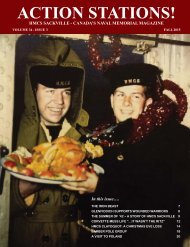ACTION STATIONS!
Action-Stations-Summer-email-and-web-issue-2016
Action-Stations-Summer-email-and-web-issue-2016
You also want an ePaper? Increase the reach of your titles
YUMPU automatically turns print PDFs into web optimized ePapers that Google loves.
KEEL-LAYING by Commander ret’d Colin Darlington<br />
The laying of the keel of a ship is one of the<br />
significant dates in that ship’s life. The<br />
date in effect marks the birth of the ship.<br />
It has been years since there was a keel laid for<br />
a ship of the Royal Canadian Navy (RCN). The<br />
keel for what became Her Majesty’s Canadian<br />
Ship (HMCS) Summerside was laid 28 March<br />
1998. Now, on 9 June 2016, the keel was laid for<br />
what will become HMCS Harry DeWolf, first of<br />
the patrol ships of the Arctic and Offshore Patrol<br />
Ship (AOPS) project. This event was the first of<br />
a number of traditional naval ceremonies in the<br />
coming years as the RCN obtains ships under the<br />
National Shipbuilding Strategy.<br />
The keel of a ship is the “primary fore-and-aft<br />
part of a ship’s frame. It runs along the bottom<br />
connecting the stem and the stern.” In a wooden<br />
or older steel ship, the keel extends the whole<br />
length of the vessel. Attached to it are the stem<br />
(the foremost steel part forming the bow), sternpost<br />
(the upright structural member at the stern)<br />
and the ribs of the vessel. This definition reflects<br />
how ships were customarily built. Nowadays a<br />
ship may be built of modules, or blocks, fabricated<br />
separately with fittings and equipment inside,<br />
then brought together to form the hull and superstructure<br />
of the ship. In the case of the patrol<br />
vessels, each is composed of three ‘mega-blocks’<br />
made up from a total of 62 smaller blocks. It<br />
can be the lowering of part or whole of the large<br />
block onto a cradle on the building ways that is<br />
the ‘keel laying’ for a modern naval vessel.<br />
and logistics involved, and of the efficiency of the<br />
shipbuilder.<br />
A keel-laying ceremony is an informal affair arranged,<br />
for the most part, by the ship’s builder.<br />
Traditionally, after gathering and a short address,<br />
a section of keel is lowered into place onto<br />
a cradle on the ways. The sponsor of the ship or<br />
senior naval representative then declares the keel<br />
“well and truly laid.” Mementoes (e.g., silver<br />
plates, silver hammers) may be presented – these<br />
become part of the official artifacts of the ship.<br />
A keel-laying ceremony traditionally invites<br />
good luck in the construction of the ship and<br />
throughout her life. Chaplains of various faiths<br />
say a few words of blessing that the ship may<br />
be protected, and older customs may take place.<br />
Elders of other nations may attend. In some navies,<br />
one custom has the senior naval representative<br />
laying a silver dollar under the keel before it<br />
is laid. In other navies, a coin may be laid by the<br />
sponsor or the youngest or oldest tradesperson of<br />
the shipyard. In the US Navy, the sponsor may<br />
be invited to weld her initials onto a metal plate<br />
which is placed in the ship. A silver hammer<br />
may be used to drive a silver nail into the keel.<br />
Whatever the customs, the intent is to keep the<br />
ceremony short, simple and in accordance with<br />
the traditions of the sea.<br />
A keel laying is a significant date because it customarily<br />
marks the start of full production of a<br />
ship. For a civil ship, the date locks in applicable<br />
construction standards. Naval construction is<br />
allowed more flexibility, and aspects of the building<br />
can be changed after a keel-laying, Much<br />
activity, such as design, ordering of material,<br />
and initial fabrication, takes place prior to laying<br />
of the keel, so in many respects that date is<br />
one of convenience for a warship. And the laying<br />
of a keel is no guarantee that the ship will be<br />
launched and completed. Ships can and have<br />
been cancelled, or converted into another type of<br />
ship, before being launched. For ship fans, the<br />
date of a keel laying is of interest, for the duration<br />
between it and the date of launching of a<br />
ship is an indication of government support to<br />
the project, of the complexity of the engineering<br />
Carl Risser, a journeyman ironworker who has been employed<br />
with Irving Shipbuilding for more than 46 years<br />
lays a ‘three dollar coin’ on the keel of Irving hull 103, 8<br />
June 2016. Mr Risser is part of a long line of Halifax shipbuilders<br />
and the second of three generations of Rissers to<br />
work at the Halifax Shipyard – both his father and his sons<br />
have worked and work there as well. He is well respected<br />
by all at the shipyard.<br />
30 Action Stations! Summer 2016



